#ampelopsis glandulosa
Explore tagged Tumblr posts
Text


#porcelain berry#wild grapes#amur pepper vine#ampelopsis glandulosa#invasive plants#knapweed#centaurea#wildflowers#pelham bay park#bronx
0 notes
Text

daily design #2 - Ampelopsis glandulosa
3 notes
·
View notes
Photo

Ampelopsis glandulosa var. heterophylla
41 notes
·
View notes
Text

今回は、野ぶどう作りました。近所に自生していたキレハノブドウです。鮮やかな実が美しいけれど美味しくないブドウ。

それと完成品ではないけど、本型の保存箱も作ってみました。古い植物図鑑みたいな感じにしたいなと。

次回は植物じゃないもの作るかも。。。
------------------------------------------------------
布花
『瞬き』
『野葡萄』
学名: Ampelopsis glandulosa var.heterophylla f. citrulloides
2020.11.28 oconica
22 notes
·
View notes
Photo

Ampelopsis glandulosa var. heterophylla
Just beautiful, not edible
27 notes
·
View notes
Photo

Time for my favorite invasive species, Ampelopsis glandulosa, aka the porcelain berry, to show its gorgeous colors again. For something that gets colorful in autumn it has a very springy palette. #fall #autumn #porcelainberry #greenery #plants #vines #creepers #invasiveplants #plantsofinstagram #plantstagram #colorful #berries #foliage https://www.instagram.com/p/CjDiccguRlt/?igshid=NGJjMDIxMWI=
#fall#autumn#porcelainberry#greenery#plants#vines#creepers#invasiveplants#plantsofinstagram#plantstagram#colorful#berries#foliage
1 note
·
View note
Photo

On a hike around the west side of Lake Johnson, I found this beautiful (but invasive) Porcelain Berry (Ampelopsis glandulosa). (at Lake Johnson Nature Park) https://www.instagram.com/p/ChfiLEyuLEf/?igshid=NGJjMDIxMWI=
0 notes
Photo

Porcelain berry (Ampelopsis brevipedunculata var. glandulosa). November 2018. The berries really are that colour; this is unedited. I hear this plant is an invasive weed in North America, yet I’ve never seen it grown by anyone else in the UK despite its tolerance of cold and shade.
#it's as good a fast climber as virginia creeper#plants#my plants#vitaceae#ampelopsis#porcelain berry#climbing plants#agavex
2 notes
·
View notes
Photo
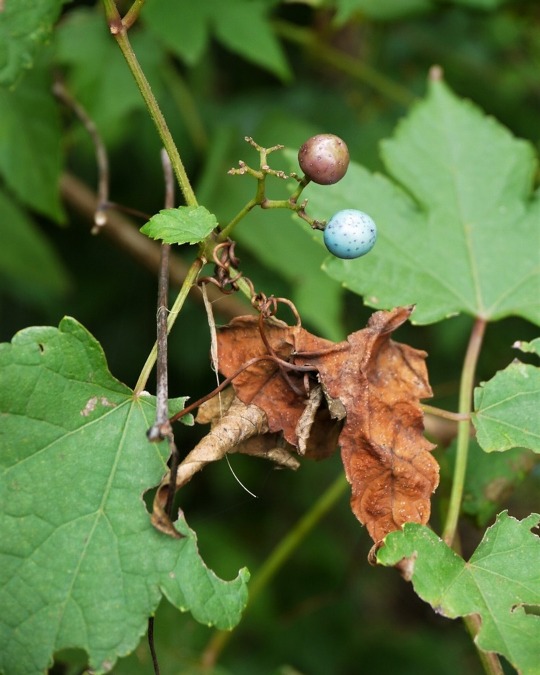
gorgeous porcelain berries in my october country. (Ampelopsis glandulosa var. heterophylia/brevipedunculata) 野蒲萄は神無月の「玉」。 #PorcelainBerry #Creeper #WeedyPlant #ノブドウ #野蒲萄 #ポーセリンベリー #野趣 https://www.instagram.com/p/B4NBIyrnGTJ/?igshid=1nkal0aocu2c3
0 notes
Photo

_Ampelopsis brevipedunculata_ ; _Ampelopsis glandulosa var. heterophylla_ #ampelopsis #ノブドウ 花弁の開き方がブドウとは逆、つまりフツウ。ブドウの花弁は雨傘のように縁側が開き、しかも支えがないので、開花と同時に地面に落ちる。
1 note
·
View note
Text




#porcelain berry#wild grapes#amur pepper vine#ampelopsis glandulosa#berries#flower buds#invasive plants#pelham bay park#bronx
1 note
·
View note
Photo

Ampelopsis glandulosa var. brevipedunculata; porcelain berry, Amur perrervine. What a beautiful leaf! #vitaceae #ampelopsisglandulosa #porcelainberry #asianplants #invasivespecies #lamacchinafissa #readingretreatsinruralitaly (presso La Macchina Fissa) https://www.instagram.com/p/BxPENQ3BaGh/?utm_source=ig_tumblr_share&igshid=akwm6dwtelyh
#vitaceae#ampelopsisglandulosa#porcelainberry#asianplants#invasivespecies#lamacchinafissa#readingretreatsinruralitaly
0 notes
Photo

. . Ampelopsis glandulosa。 . 野葡萄(小さいやつ)の実の色が 美しすぎて…♪ . 快晴だけど 木枯らし🍃みたいな 風の強い日でしたね… . @igersjp #自然部門エントリー . #草花を楽しむ暮らし . #flower #flowerlovers #team_jp_flower #picture_to_keep #ptk_flowers #icu_nature #chineselanternplant #ir_flowers #instagramjapan #loves_flowers_ #Ig_Flowers #bd_flower #bd_garden #natureaddictsun #FloralWaltz #favv_flowers #ip_blossoms #icapture_mobile #9vaga_flowersart9 #野ブドウ #野葡萄#花屋 #ザ花部 #JHP芸術の秋 https://www.instagram.com/p/8iEbdTtlNd/?utm_source=ig_tumblr_share&igshid=asr03t1t076l
#自然部門エントリー#草花を楽しむ暮らし#flower#flowerlovers#team_jp_flower#picture_to_keep#ptk_flowers#icu_nature#chineselanternplant#ir_flowers#instagramjapan#loves_flowers_#ig_flowers#bd_flower#bd_garden#natureaddictsun#floralwaltz#favv_flowers#ip_blossoms#icapture_mobile#9vaga_flowersart9#野ブドウ#野葡萄#花屋#ザ花部#jhp芸術の秋
0 notes
Photo








Porcelain-berry; Amur Peppervine; Wild Grape (Ampelopsis brevipedunculata) syn. Ampelopsis glandulosa var. brevipedunculata
Mature Size - (15-25′ x 15-25′)
Shape and Form - Woody, deciduous, tendril-climbing vine which is somewhat similar in habit to wild grape vines.
Growth Habit - Vigorous growth. Stems climb by tendrils.
Leaves - Features mostly 3-lobed, deep green leaves (to 5" long).
Flowers - Clusters (cymes) of non-showy, greenish flowers appear in the leaf axils in July. Flowers are important source for pollinators.
Fruit/Seeds - Flowers give way in fall to showy clusters of rounded-to-oval, pale lilac-blue fruits (1/4" diameter) which mature to brighter and deeper shades of amethyst to porcelain blue. Fruits attract birds and squirrels.
Bark - Stems are thin, green, and slightly zig-zag the first year, becoming brown, semi-woody, and somewhat exfoliating by the second year. Stems climb not by twining, but rather by tendrils twisting around a supportive structure. Stems may also run along the ground, over logs and rocks, and entangle upon other stems, making them very hard or impossible to separate.
Region - Native to temperate regions of northeastern Asia. Has naturalized in much of eastern North America, to the Great Lakes region.
Hardiness Zones - (4-8)
Habitat/Growing Conditions - Grows in open sites, and is often associated with disturbed or degraded landscapes. It invades streambanks, pond margins, forest edges and other disturbed areas. Easily grown in average, medium, well-drained soil in sun or shade. Adapts well to most soils, including sandy or rocky ones. Avoid wet, poorly drained soils, however. Best flower and subsequent fruit production occur in full sun. Needs a support structure upon which to grow, including fences, arbors, walls, trellises, porches or other structures. May also be grown without support along the ground to cover old stumps or rock piles.
Plant Community - Spontaneous Urban Growth
Eco-indicator - NA
Other info - Flowers on new growth, so this vine may be cut to the ground in late winter (optional) to control growth.
Porcelain Berry is closely related to grape vines. Its flowers are attractive to pollinators, and its berries are eaten by a number of birds and squirrels.
An invasive species, often problematic in North America. Most problematic along coastal areas. The thick mats formed by this climbing vine can cover and shade out native shrubs and young trees. It spreads very quickly since birds and mammals eat the fruit and disperse the seeds.
Current Nursery Status and Availability - Most widely used pine in the northeast. Easily available in nursery trade, as are several cultivars. Dirr lists 3 selections of this species in his 6th edition woody plants manual
‘Citrulloides’ - Leaves are deeply incised, 5-lobed, with typical green flowers and bluish fruit.
‘Elegans’ - A rather interesting type with slightly smaller leaves, variegated with white. Greenish white and tinged with pink when young. Not as vigorous as species, and would be a good choice for locations where the species is too aggressive.
var. maximowiczii (syn. A. glandulosa) - Leaves more deeply lobed, 3-5 lobes. Interesting textural difference compared to species. Incredibly vigorous, which can be a problem.
http://www.missouribotanicalgarden.org/PlantFinder/PlantFinderDetails.aspx?taxonid=287549&isprofile=0&
https://hvp.osu.edu/pocketgardener/source/description/am_ulata.html
https://www.fs.fed.us/database/feis/plants/vine/ampbre/all.html
https://plants.ces.ncsu.edu/plants/all/ampelopsis-brevipedunculata/
Dirr - “Manual of Woody Landscape Plants”
Wessels - “Reading the Forested Landscape”
#zone4#zone5#zone6#zone7#zone8#showy fruit#blue fruit#rapid growth rate#tolerates poor soils#high wildlife value#groundcover#spontaneous urban growth
0 notes
Photo

Ampelopsis glandulosa var. heterophylla
https://blogs.yahoo.co.jp/naturetakarazuka/14542354.html
9 notes
·
View notes
Text
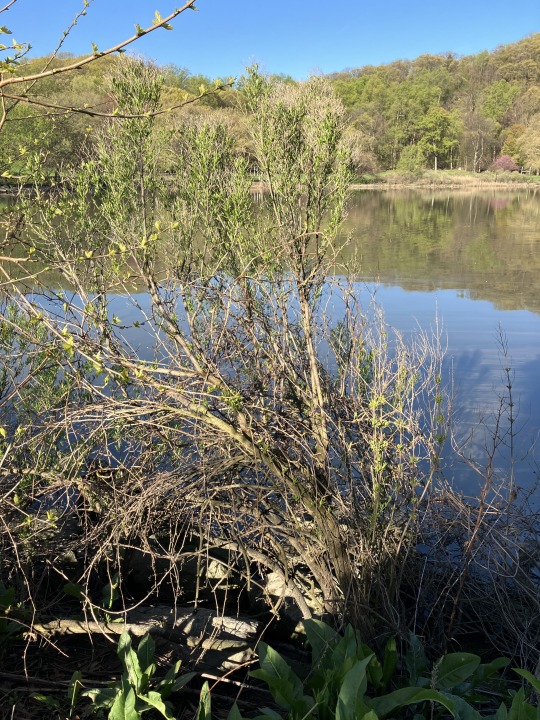
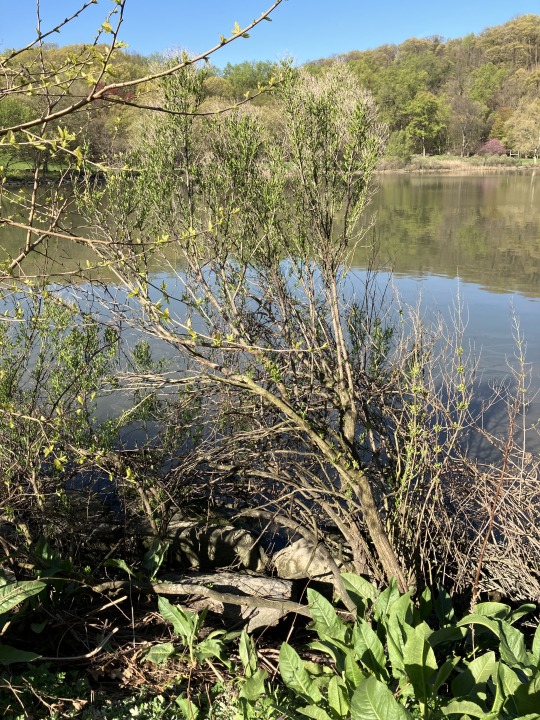
Spent my morning pruning hour at work on this groundsel bush (a native salt marsh species also known as Baccharis halimifolia) that was covered in porcelainberry (Ampelopsis glandulosa var. brevipedunculata), an invasive species of grape. Cherished mutual (of nine years! wow!) @islenskur mentioned not knowing much about the invasive species I work on so here's a little primer for anyone interested.
Porcelainberry is from eastern Asia and was imported to the United States in the late 19th century as an ornamental landscaping plant - it has since gone rogue and is all over the East Coast and has been found as far west as Iowa. The good people of the Lewis Ginter Botanical Garden in Virginia said porcelainberry is "the most pervasive of all invasive plants" they are dealing with. It's a woody vine that can grow as tall as 20 ft, can grow in just about any environment include damp and shaded areas, and has a massive root system so it's also incredibly difficult to eradicate. It grows so quickly and so prolifically that it can easily shade out other plants in the understory and it will also easily cover an entire tree and engulf it -- if you find an undisturbed thicket of porcelainberry, it is probably a monoculture as it has killed or outcompeted everything in the area. Furthermore, since it can regrow from root fragments, it cannot be composted. As high risk of an invasive species as it is, porcelainberry is still sold in the horticulture trade, although it has since been banned in Delaware.
Porcelainberry seeds are spread by birds and small mammals like squirrels that eat the small, marble-like berries that form in the summer; they're actually really beautiful and vary in colour from a robin's egg blue to a deep midnight purple. While they are edible, they taste nasty, so if you like bland berries with a somewhat stinging aftertaste and a slimy texture, these are a perfect snack. The leaves are also edible and not disgusting (I've actually used them to make dolmades aka stuffed grapes leaves and the texture was no different than cultivated grape leaves) and they look quite lovely on a cast iron fence -- zoom in on the little tendrils that it uses to cling to itself and other objects to make a lattice and quickly grow upwards. These tendrils are a big tell for identifying porcelainberry in the winter when there are no leaves, as other clinging/climbing vines like Asian bittersweet, English ivy, and poison ivy have different ways of attaching to the trees.
As much as I hate dealing with it, I have to admit that this plant is incredibly good at thriving in adverse conditions.
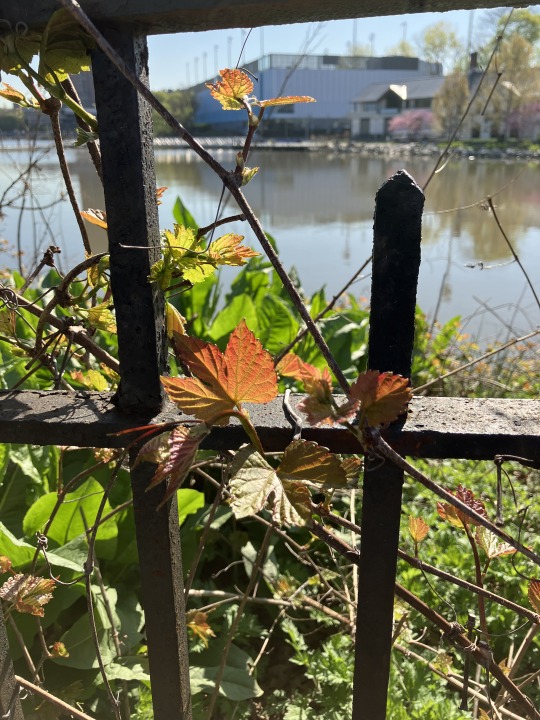

Bonus: it can be hard to see how much is removed just from before-after pictures so here’s the cleanup result:
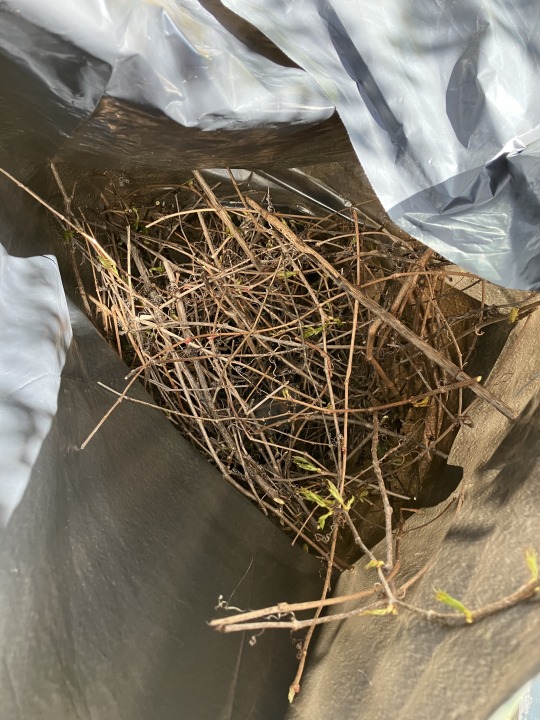
4 notes
·
View notes